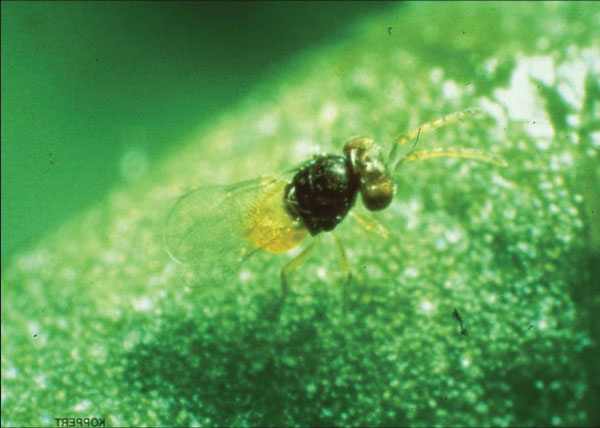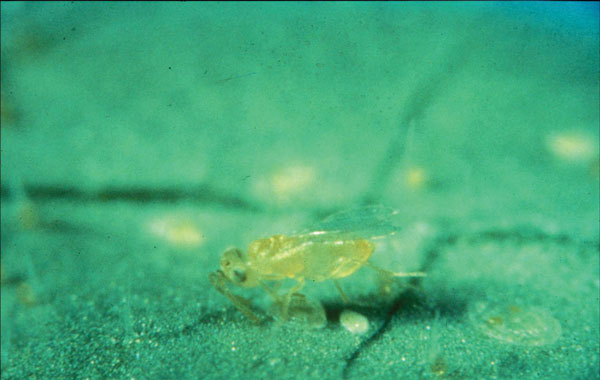8/1/2020
Host Feeding by Parasitoids
Dr. Raymond A. Cloyd

Parasitoids or parasitic wasps used in biological control programs can kill insect pests by laying eggs into or on the body of an insect or host (this is called parasitism). The larva hatches from the egg inside (or outside) the body of an insect and then feeds on the internal contents. The larva eventually pupates and then becomes an adult. The adult creates a hole in the cavity of the dead host and then flies away. In addition to laying eggs into or on available hosts, adult female parasitoids may also host feed.
Figure 1. Encarsia formosa, which is a parasitoid of the greenhouse housefly, will host feed on the fluids exuded from hosts after inserting her ovipositor.
Host feeding is the ingestion or consumption of body fluids that exude from wounds (punctures) created by an adult female parasitoid, using her ovipositor (egg laying device) when piercing the body of a host (Figure 1). Adult female parasitoids then feed on the fluids using the host as a food source. Host feeding allows female parasitoids to obtain nutrients that are important for egg maturation and production, which increases their egg load.
Host feeding can help female parasitoids assess the quality of the host for her progeny or young (Figure 2). The fluids exuded during host feeding contain proteins, vitamins and salts that are essential for reproduction or increase reproductive potential. Any carbohydrates, proteins, lipids and other materials that are ingested during host feeding are broken down into simple molecules in the stomach or blood (hemolymph). These molecules are then absorbed, translocated and reassembled in the internal tissues of the parasitoid. The life stages of insect pests that are susceptible to host feeding include eggs, larvae and pupae.
A number of parasitoids are known to host feed, such as Encarsia formosa (parasitoid of the greenhouse whitefly), Diglyphus isaea (parasitoid of leafminer larva), Aphytis melinus (parasitoid of hard scales), and Metaphycus helvolus (parasitoid of soft scales).
Why host feed?
The benefits of host feeding are a potential increase in fecundity (ability to produce an abundance of offspring) and longevity (increased lifespan). Host feeding results in obtaining essential nutrients needed for egg maturation, which can lead to an increase in reproduction. Host feeding will increase when parasitoids require nutrients to avoid starvation or ensure egg maturation.
Host feeding may also lead to an increase in longevity. However, sometimes, host feeding doesn’t result in an increase in longevity. The effect of host feeding on longevity can vary depending on the parasitoid species and may be affiliated with the types of nutrients ingested, especially the different levels of sugars present in the fluid and the metabolism of nutrients obtained from host feeding. For instance, there are reports that host feeding by Encarsia formosa doesn’t result in an increase in longevity.
Factors that influence host feeding are associated with the host (e.g., quality, availability and distribution) and the parasitoid (e.g., age and nutrient reserves). Parasitoids can decide whether to host feed or not, depending on host quality. Moreover, hosts will vary in quality for host feeding or egg laying, depending on age and size. In fact, host size may serve as an indirect indicator of age and potential quality. Therefore, low-quality hosts may be used for host feeding, whereas high-quality hosts are used for laying eggs due to a higher potential for offspring survival.
In addition, the quality of hosts depends on size, as smaller hosts may be considered lower quality, but larger hosts are considered higher quality. As host size increases, host quality is more suitable for egg laying and progeny development. The reason being is that larger hosts contain more nutrients and may result in the production of larger parasitoid offspring. In contrast, earlier life stages (1st and 2nd instar larvae) of hosts, which are typically smaller, are used for host feeding rather than for egg laying.
Parasitoid age can influence host feeding. For example, young parasitoids tend to host feed more than older parasitoids. Host feeding declines as female parasitoids age and reach the end of their reproductive life because there’s no benefit in host feeding.
 Figure 2. Some parasitoids assess the quality of the host before laying eggs. Photo: Raymond Cloyd, KSU.
Figure 2. Some parasitoids assess the quality of the host before laying eggs. Photo: Raymond Cloyd, KSU.
Host feeding can result in an increase in killing hosts. In fact, host feeding may contribute 15% to 40% of the total mortality of an insect pest population. However, a drawback of host feeding is that if hosts are killed, then they’re not suitable for progeny survival and development, which impacts future reproduction. Even if hosts aren’t killed, host quality may be compromised, thus rendering hosts unsuitable for egg laying, and subsequent progeny survival and development. Furthermore, if hosts are killed, then any nutrients consumed by the female parasitoid results in a reduction of resources available for developing offspring.
In some cases, hosts will survive long enough after host feeding to support the development of parasitoid offspring. Consequently, some parasitoids will feed on and lay eggs in the same host. However, offspring that emerge from hosts that were fed upon may be smaller than offspring that emerge from hosts that weren’t fed upon. Another drawback of host feeding is that feeding on hosts takes more time than egg laying, which can reduce the time parasitoids spend searching for hosts.
In conclusion, some parasitoids that are released into enclosed environments, such as greenhouse production systems, may regulate insect pest populations by killing them when laying eggs or when host feeding. GT
Dr. Raymond A. Cloyd is Professor and Extension Specialist in Horticultural Entomology/Plant Protection for the Department of Entomology at Kansas State University.